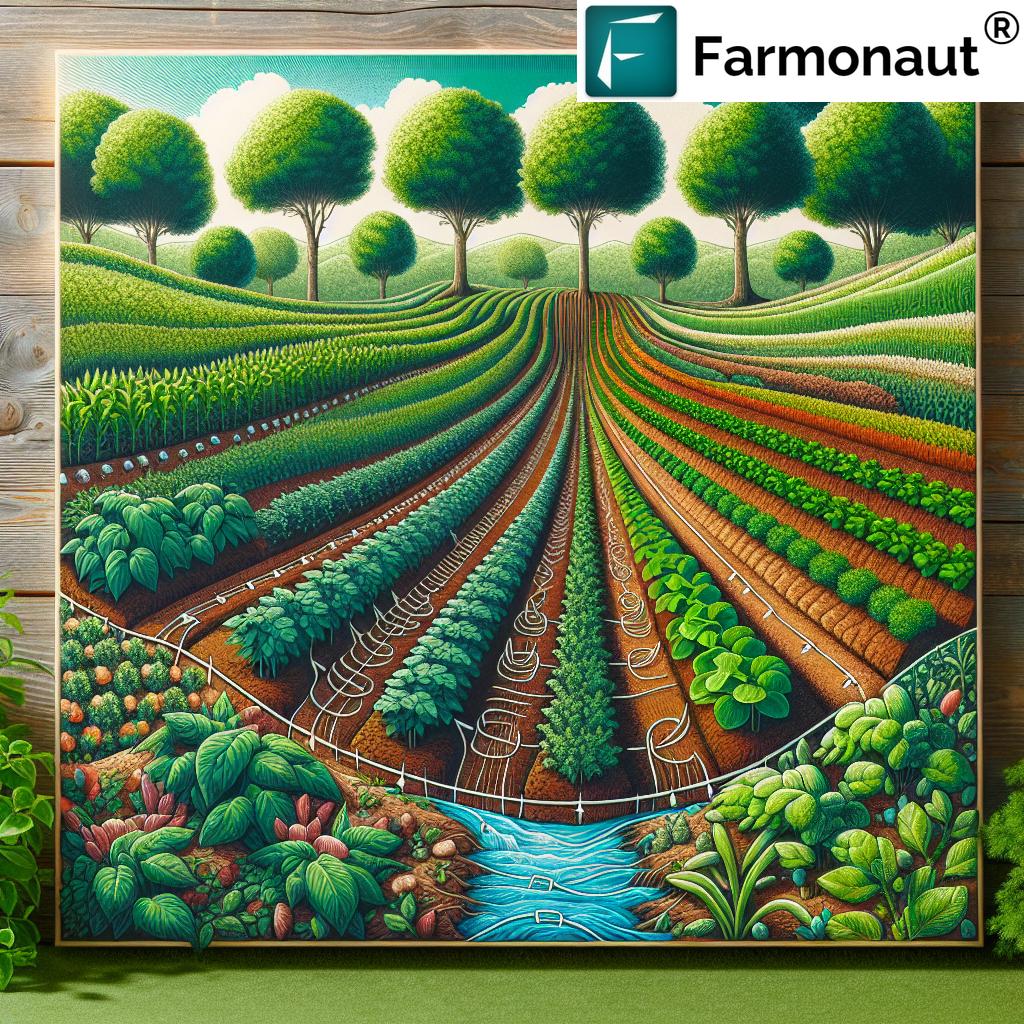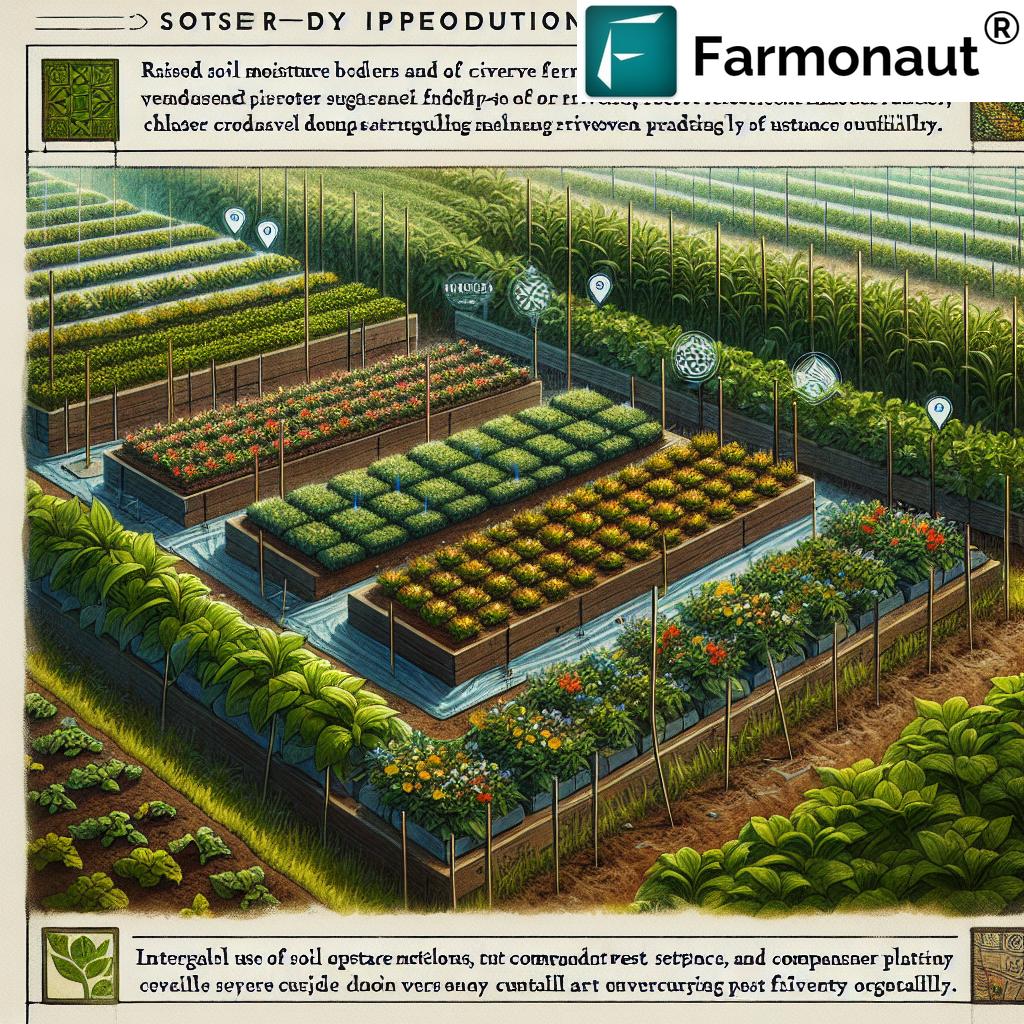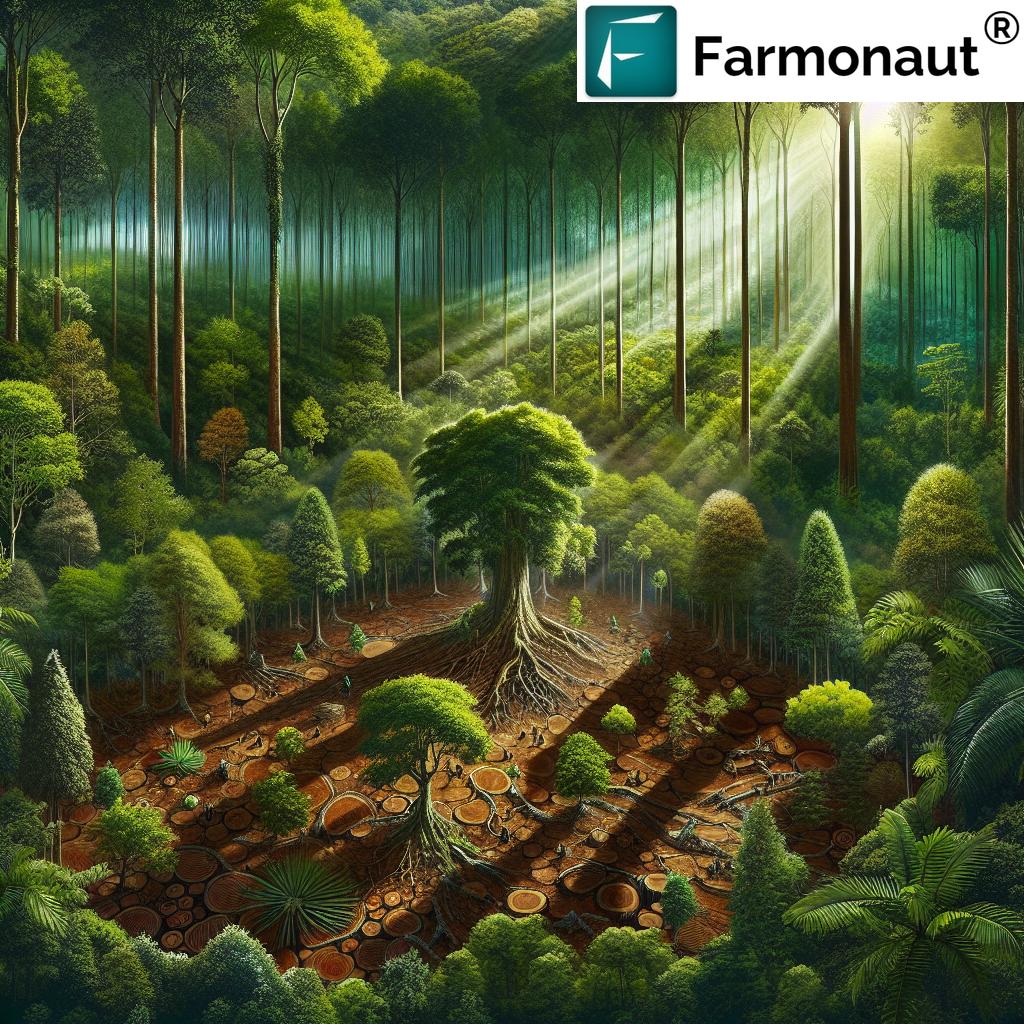Table of Contents
- Introduction: Why Farming Techniques Matter
- Comparative Features Table: 7 Farming Techniques
- Traditional Farming Techniques
- Modern Farming Methods
- Sustainable Agriculture Practices
- Forestry Techniques and Agroforestry Systems
- Precision Agriculture & Farmonaut’s Data Solutions
- Challenges and Future of Agricultural Innovation
- Frequently Asked Questions
- Farmonaut Subscription Options
“No-till farming can reduce soil erosion by up to 90% compared to conventional tillage methods.”
7 Farming Techniques That Will Revolutionize Your Harvest
Farming techniques have experienced a remarkable transformation, blending time-honored traditions with groundbreaking innovations and scientific advancements. Across diverse climates and soils, we, as farmers and stewards of the land, continuously strive for increased crop productivity, improved soil fertility management, and robust environmental stewardship. In this comprehensive guide, we’ll explore 7 essential farming techniques that can revolutionize your harvest—whether you’re adapting traditional knowledge or integrating modern farming methods.
Our mission is clear: to reveal how sustainable agriculture practices—when thoughtfully employed—can help us reduce resource use, enhance biodiversity, ensure soil health, and secure the long-term productivity of our fields. Let’s delve into these transformative methods, their real-world benefits, and how technology innovators like Farmonaut make them accessible for farmers worldwide.
Comparative Features and Impact Table: 7 Revolutionary Farming Techniques
To assist you in understanding and choosing the most suitable practices, here’s a side-by-side comparison of our top 7 farming techniques. This table highlights estimated yield improvements, environmental impact, reduction in resource use, technology requirements, and more—helping both large agribusinesses and small-scale farms.
| Farming Technique | Description | Estimated Yield Improvement (%) | Environmental Impact | Resource Efficiency (Water/Fertilizer Use Reduction %) |
Technology Required | Adoption Difficulty |
|---|---|---|---|---|---|---|
| Crop Rotation | Rotating diverse crops across seasons to improve soil fertility and disrupt pest cycles. | 5–15% | Low | Up to 20% | Low | Easy |
| Intercropping | Growing two or more crops in close proximity for mutual benefits. | 10–20% | Low | 15–30% | Low | Moderate |
| No-Till Farming | Minimizes soil disturbance to improve structure, reduce erosion, and increase water retention. | 8–13% | Low | 20–50% | Medium | Moderate |
| Agroforestry Systems | Integrating trees and shrubs into farms for biodiversity, carbon sequestration, and diversified income. | 10–25% | Low | 20–40% | Medium | Challenging |
| Precision Agriculture Technology | Using GPS, satellite imagery, sensors, and analytics for targeted resource application and crop monitoring. | 15–30% | Low | 30–70% | High | Challenging |
| Integrated Pest Management (IPM) | Combining biological, cultural, chemical, and physical practices to manage pests ecologically. | 7–20% | Medium | 20–50% | Medium | Moderate |
| Water Conservation in Agriculture | Techniques like drip irrigation, rainwater harvesting, and moisture management to sustain soils and crops. | 5–18% | Low | 40–80% | Medium | Moderate |
As we implement these revolutionary techniques, it’s crucial to leverage the latest data-driven insights and tools. With Farmonaut, our farm management can benefit from real-time carbon footprint tracking, transparent crop traceability, powerful fleet management, and API integration for large-scale analytics (API Access | Developer Docs).
Traditional Farming Techniques: Building on Legacy
Our agricultural journey begins with “traditional farming techniques.” These are not just historical relics; they remain highly effective for many local climates and soil types. Let’s revisit the top three:
1. Crop Rotation
-
What is it?
Crop rotation simply means planting different crops—for example, legumes, cereals, and root crops—in the same field across subsequent seasons. Each plant family interacts differently with the soil, drawing or replenishing unique nutrients. -
Benefits
By cycling crops, we improve soil fertility, reduce pest infestations, and break disease cycles. For example, growing nitrogen-fixing beans after a heavy-feeding crop (like maize) restores key soil nutrients. -
Productivity Impact
Research and local knowledge confirm that thoughtful crop rotation enhances yields and reduces the reliance on chemical fertilizers.
2. Intercropping
-
What is it?
Intercropping involves growing two or more crops together in proximity. Classic examples are maize-bean-squash, or millet with legumes. -
Benefits
Crops support each other: beans add nitrogen, tall plants offer shade, and dense planting suppresses weeds. This method balances the ecosystem, increases biodiversity, and offers “insurance” against total crop failure. -
Improved Soil Health
These mixed cropping systems result in more stable fields, richer soil organic matter, and natural pest control.
3. Agroforestry Systems
-
What is it?
Agroforestry means integrating trees and shrubs with crops or livestock on the same land. Intermixing perennial plants and annual fields, we foster roots at different depths and create layered canopies. -
Benefits
Trees act as windbreaks, stabilize soil structure, enhance shade and water retention, and store carbon—supporting robust ecosystems. -
Environmental Stewardship
Agroforestry is now increasingly valued for its role in carbon sequestration, improved biodiversity, and long-term farm resilience.
“Cover cropping increases soil organic matter by 15-30% within five years, enhancing long-term farm productivity.”
Modern Farming Methods for Improved Crop Productivity
As the world’s population grows and arable land becomes scarce, we must rely on modern farming methods to optimize resources. Key innovations like no-till farming, conservation agriculture, and precision agriculture technology are revolutionizing how we approach agriculture.
4. No-Till Farming
-
What is it?
Rather than plowing (tilling), we use special seed drills to plant crops directly into soil covered by previous crop residues. This minimizes soil disturbance and preserves precious organic layers. -
Benefits
No-till farming reduces erosion, enhances water retention, lowers labor costs, and supports beneficial microbial processes. -
Technological Integration
When synced with real-time field maps and digital decision tools (e.g., Farmonaut’s AI advisory), no-till fields deliver even greater sustainability and productivity.
5. Conservation Agriculture
-
What is it?
This innovative approach relies on three principles:- Minimal soil disturbance (reduced tillage)
- Maintaining a permanent soil cover (mulch, crop residues)
- Diversifying plant species (rotation, cover crops)
-
Benefits
Conservation agriculture improves soil structure, prevents erosion, moderates soil temperature, and fosters resilient crop growth. It is especially effective in arid and semi-arid regions. -
Long-term Impact
Research from universities and NGOs establishes that farms using this method see significant yield stability and ecosystem improvement—even under climate change.
6. Precision Agriculture Technology
-
What is it?
Precision agriculture employs GPS, remote sensors, drones, and satellite images to collect data about our fields. Using these insights, we can apply water, fertilizers, and pesticides only when and where they are needed most. -
Benefits
By optimizing resource use and minimizing waste, this approach leads to cost efficiency, environmental conservation, and higher yields. -
Farmonaut’s Role
Through Farmonaut’s satellite-based farm management platform, smallholders and large farms alike access real-time crop health, soil moisture, and pest risk analytics in a highly affordable package.
-
Want to add remote crop traceability and carbon impact reporting?
Learn more about carbon footprint reduction tools and blockchain crop traceability.
Sustainable Agriculture Practices: Focusing on the Future
“Sustainability” isn’t just a buzzword. Sustainable agriculture practices help us meet our present needs without compromising the future. The following techniques build farm resilience and environmental harmony for generations to come.
7. Organic Farming
-
What is it?
Organic farming avoids synthetic fertilizers and pesticides. Instead, we use natural compost, green manures, and biological pest management to nourish crops and protect soil. -
Benefits
Organically managed fields show better soil structure, higher biodiversity, and lower risk of chemical pollution. -
Certification
While it requires planning and compliance, organic produce often commands a higher market price.
Integrated Pest Management (IPM)
-
What is it?
IPM combines biological (natural predators), cultural (timing, crop rotation), physical (barriers, traps), and chemical (targeted pesticides) tools to control pests with minimal environmental disruption. -
Benefits
We balance economical and ecological pest management, reduce chemical dependence, and build more resilient cropping systems.
Water Conservation in Agriculture
-
What is it?
Saving every drop matters: We utilize drip irrigation, rainwater harvesting, mulching, and advanced soil moisture management to maximize water-use efficiency, especially in water-scarce regions. -
Benefits
With these systems, resource use is minimized, crop yields increase, and we contribute to sustainable food production even under drought risk. -
Want expert water management advice?
Try the Farmonaut crop and forest advisory solution for remote analytics on field moisture and optimal irrigation plans.
Forestry Techniques and Agroforestry Systems for Environmental Stewardship
Forestry is not limited to timber production; it is vital for ecosystem management, biodiversity, and carbon sequestration. Our focus is on techniques that blend conservation with productive use.
- Selective Logging: Removing only targeted trees minimizes damage and supports natural regeneration.
- Agroforestry in Forestry: Integrating commercial trees (like fruit or nut species) with annual crops spreads risk and maximizes land output. Learn more about agroforestry here.
- Reforestation and Afforestation: Planting new trees restores lost forests and helps mitigate climate change. Such efforts are often mapped and monitored using satellite platforms for maximum accountability and efficiency.
- Digital Forestry: Using tools like Farmonaut large-scale management solutions enables robust tracking of plantation, restoration, and conservation programs.
Precision Agriculture Technologies: Farmonaut’s Vision for the Future
Across each of these farming techniques, Farmonaut serves as a beacon for affordable innovation, integrating satellite imagery, AI, and blockchain to empower both smallholders and agribusinesses:
- Satellite-Based Crop Health Monitoring: Receive insights on vegetation health, soil moisture, and real-time pest risks.
- AI Advisory System: Jeevn AI delivers personalized recommendations—when to irrigate, fertilize, or take action for pests—based on current weather and field data.
-
Blockchain Traceability: Ensure every stage of your crops’ journey is tracked and tamper-proof, building transparency for retailers and consumers alike.
Explore transparent supply chain solutions. -
Fleet and Resource Management: Track and optimize lorries, tractors, and more.
Discover Farmonaut Fleet Management solutions. - Carbon Footprinting: Monitor emissions, reduce input waste, and prove your sustainability credentials with Farmonaut carbon reporting tools.
All these core features can be accessed through Farmonaut’s:
- Web app and API for researchers, developers, and data science teams: API Access | Developer Docs
- Android and iOS apps for mobile real-time farm monitoring: Get it on Google Play | Download on App Store
These tools empower us to make smarter decisions, practice sustainable agriculture, and meet the challenges of the next farming revolution.
Challenges and the Future of Innovative Farming Methods
Even with transformative methods at hand, we face persistent challenges—climate volatility, declining soil fertility, unpredictable markets, and resource scarcity. Here’s how we can address them, together:
-
Climate Change Adaptation:
Incorporating resilient crop species, changing planting schedules, and embracing conservation and agroforestry systems can buffer against erratic weather patterns. -
Soil Degradation:
No-till, cover cropping, integrated pest management, and precision agriculture technology directly restore and safeguard soil health. -
Resource Limitations:
By embracing water-saving technologies and GPS-driven input application, we can maximize output with minimal input. -
Technology Access:
With solutions like Farmonaut—designed for affordability and ease-of-use—farmers worldwide can leap into the digital age, boosting yields, sustainability, and traceability above traditional barriers. -
Future Outlook:
We anticipate deeper use of AI, machine learning, and data analytics—powered by real-time field, weather, and satellite data—to make farming more efficient, predictable, and resilient.
Farmonaut Subscription Options
Ready to unlock advanced crop monitoring, farm analytics, and sustainable management?
Explore subscription plans for individuals, agribusinesses, researchers, and government users:
Frequently Asked Questions (FAQ): Modern & Sustainable Farming Techniques
-
Q1: Which farming technique delivers the fastest improvement in crop yields?
A: While immediate results are seen with precision agriculture technology and integrated pest management (IPM), adopting conservation agriculture and crop rotation consistently improves yields within a few seasons due to soil health restoration.
-
Q2: Can these techniques work on smallholder farms with minimal technology?
A: Absolutely. Many traditional farming techniques, like intercropping and crop rotation, require little capital investment. For more advanced options, platforms like Farmonaut offer affordable access—even for smaller acreages.
-
Q3: How does farm management contribute to environmental stewardship?
A: By implementing sustainable agriculture practices—no-till, organic management, water conservation—we reduce pollution, enhance biodiversity, and build climate resilience for this generation and the next.
-
Q4: How can I monitor and verify my farm’s carbon footprint?
A: Utilize the Farmonaut Carbon Footprinting tools for real-time emissions tracking, sustainability reporting, and environmentally friendly branding.
-
Q5: How can I start using Farmonaut on my farm?
A: It’s simple—register on:
and select your monitoring options.
-
Q6: Where can I find API access for large-scale or research-based farm analytics?
A: Review the Farmonaut API guide and consult the developer docs for advanced integration.
Conclusion: Shaping the Future With Revolutionary Farming Techniques
Our journey through these seven transformative farming techniques reveals a bigger picture: The future of agriculture is both innovative and rooted in stewardship. By integrating traditional farming techniques with modern farming methods and precision agriculture technology, we can build more sustainable agriculture systems, ensure improved crop productivity, restore soil health, and secure food for the world. With digital tools like Farmonaut at our fingertips—no matter where we farm—we’re equipped not just to survive, but to thrive.
Ready to revolutionize your harvest? Adopt these techniques, combine innovation with knowledge, and join the next wave in agriculture!












